rhd
0
- Joined
- Dec 7, 2010
- Messages
- 8,475
- Points
- 0
There are a number of small lasers on this forum, and there are a number of beginner level tutorials for building the hotlight or guidesman, etc. But I thought it would be nice to have a tutorial for beginner-to-intermediate level hobbyists combining the two.
So I took the morning to put together this walk-through aimed at building a fairly simple, tiny, low-powered 445 laser. It's not quite as easy as building the infamous hotlight kit, but it's also fairly doable for anyone with decent soldering skills. I've seen this build elsewhere on the board, so I don't take credit for the host or for originality, but this is the first walk-through I know of. The best part? It's cheap, small, sexy looking, has two power levels and a strobe, and it's fairly easy to create! Enjoy!
Sneak peak at the final creation:

Here it is in action:
http://www.youtube.com/watch?v=zTr-mj_n07I
Parts Needed:
- TrustFire XP-EF23 (here) for $14
- 445nm diode (DTR, Daguin, etc) for $45
- Aixiz module with acryllic lens (ebay, aixiz, o-like, stonetek, etc) for $3
- 10uF 16V SMD Ceramic Capacitor (anywhere, digikey, mouser, ebay, etc) for < $1
- Plus some solder, thermal adhesive, flexible wire, a tiny bit of shrink tubing, and an afternoon for $2 (your time is free!)
Total Cost: ~$65
Step one, grab the XP-EF23 from DX. Here's what it looks like when it arrives.

Next, you're going to unscrew the LED module from the head of the host. No special tools are required for this. With your pinky finger, just unscrew it counter-clockwise.

The entire LED and driver module are housed in a fairly small enclosure. The driver and battery contact are one item at the rear of this photo (that part you see) and the LED itself is on the other end (facing away from the camera). With an xacto knife, cut the wires at the LED and use some needle nosed pliers to pull the LED off. This part isn't shown, but it's an easy step.

The driver isn't glued to the module, but there are a few tiny lines of solder around the edge of it. You may need to run an xacto knife around the edge of the battery contact pad so that you can remove the driver from the module (as shown in this photo). At the left of this photo you'll see the original metal reflector lens.

Now it's time to prepare the diode. Press your 445 into an Aixiz. Because we're going to use the flashlights original LED driver, we'll want to add an SMD ceramic capacitor to the diode itself, in order to protect it from an misbehavior on the part of the driver. My approach is to solder a ceramic SMD capacitor right onto the diode's leads. This is the only part of this build that might require a bit more than beginner soldering skills. A pair of tweezers will help you position the capacitor across the leads. Then very very short soldering iron contact should do the trick. Remember, discharge your capacitor first in case it has any residual charge to it. I solder one lead, and then let it all cool down, before introducing heat to the other lead. Then, the same for both of the lead wires. Not shown in this photo is the shrink tubing I put around these wires+cap once complete. Make sure you don't use any more shrink tubing than necessary, because this still needs to fit inside another component in the next few steps.

Here's where we put it all together. Feed the wires through the original metal reflector lens, and FILL the reflector lens with arctic silver thermal epoxy. This is a crucial step, because the majority of heat generated needs to flow back to the host via this assembly. The wires come out the back end, and you'll want to clip them as short as possible while still allowing yourself the ability to solder them to the driver. Remove the stock driver leads, and in their place, attach the leads coming off your diode.

Press the driver back into the module, and add a few thin strips of solder around the edge of the driver's battery pad to re-connect the driver's edge to the edge of the module. You need this step because the driver gets the (-) feed from the battery from the body of the host itself, so there needs to be a good connection again.

Screw the finished module back into the host itself, and add a 10440 battery. With a freshly charged (low end generic) 10440 battery, this build puts out 300mW raw optical output. It might go higher with some higher-drain 10440s (like the ones they use in "e-cigarettes" or the ones they sell at LightHound). However, since we're trying to minimize complexity, I want to be able to use the original Aixiz acrylic lens that we got with our Aixiz module. Wisdom on the forum seems to suggest that 300mW is about the maximum output power that you'd want to shoot through an acrylic lens, so keeping the output power restricted to below 300mW is desirable here.

Advanced Mods / Ideas to Upgrade your Build!
There are a few small additional steps you can take to make this build even cooler, for not a lot of extra time or cost!
- Better Driver -
The stock driver here is decent, but there are better alternatives that will fit the same form factor. Consider grabbing the AK-007 driver that was discussed in this thread: http://laserpointerforums.com/f67/new-better-1w-budget-boost-driver-ak-007-a-62548.html You should be able to DOUBLE the output power of the laser, without adding any complexity to the build. Both drivers are the same size, so it's essentially an easy swap.
- Better Lens -
For about $10 from a number of sources online and on this forum you can buy a 445nm coated glass lens to replace the stock acrylic aixiz lens that came with your module. Note that if you do the driver upgrade above, you'll NEED to do this lens upgrade too, because the output power you'll see with the better driver is likely to be too much for the basic acrylic lens.
- Don't Use the Reflector -
Instead of thermal epoxying the aixiz module into the reflector, and then attaching that to the module/driver, you could toss the reflector altogether. If you choose this approach, the aixiz module won't stick out of the end of the build, and the end result will be an even small laser. You may also benefit from better heat conduction (though it's a bit of a catch 22 because you'll also loose the aixiz module's exposure to air for cooling). The added complexity here comes from the fact that you'll need to drill out the middle of the copper-coloured LED module, because it isn't completely hollow inside. It will need to be hollow inside if you want to press the aixiz module directly into it, instead of into the reflector first.
So I took the morning to put together this walk-through aimed at building a fairly simple, tiny, low-powered 445 laser. It's not quite as easy as building the infamous hotlight kit, but it's also fairly doable for anyone with decent soldering skills. I've seen this build elsewhere on the board, so I don't take credit for the host or for originality, but this is the first walk-through I know of. The best part? It's cheap, small, sexy looking, has two power levels and a strobe, and it's fairly easy to create! Enjoy!
Sneak peak at the final creation:
Here it is in action:
http://www.youtube.com/watch?v=zTr-mj_n07I
Parts Needed:
- TrustFire XP-EF23 (here) for $14
- 445nm diode (DTR, Daguin, etc) for $45
- Aixiz module with acryllic lens (ebay, aixiz, o-like, stonetek, etc) for $3
- 10uF 16V SMD Ceramic Capacitor (anywhere, digikey, mouser, ebay, etc) for < $1
- Plus some solder, thermal adhesive, flexible wire, a tiny bit of shrink tubing, and an afternoon for $2 (your time is free!)
Total Cost: ~$65
Step one, grab the XP-EF23 from DX. Here's what it looks like when it arrives.
Next, you're going to unscrew the LED module from the head of the host. No special tools are required for this. With your pinky finger, just unscrew it counter-clockwise.
The entire LED and driver module are housed in a fairly small enclosure. The driver and battery contact are one item at the rear of this photo (that part you see) and the LED itself is on the other end (facing away from the camera). With an xacto knife, cut the wires at the LED and use some needle nosed pliers to pull the LED off. This part isn't shown, but it's an easy step.
The driver isn't glued to the module, but there are a few tiny lines of solder around the edge of it. You may need to run an xacto knife around the edge of the battery contact pad so that you can remove the driver from the module (as shown in this photo). At the left of this photo you'll see the original metal reflector lens.
Now it's time to prepare the diode. Press your 445 into an Aixiz. Because we're going to use the flashlights original LED driver, we'll want to add an SMD ceramic capacitor to the diode itself, in order to protect it from an misbehavior on the part of the driver. My approach is to solder a ceramic SMD capacitor right onto the diode's leads. This is the only part of this build that might require a bit more than beginner soldering skills. A pair of tweezers will help you position the capacitor across the leads. Then very very short soldering iron contact should do the trick. Remember, discharge your capacitor first in case it has any residual charge to it. I solder one lead, and then let it all cool down, before introducing heat to the other lead. Then, the same for both of the lead wires. Not shown in this photo is the shrink tubing I put around these wires+cap once complete. Make sure you don't use any more shrink tubing than necessary, because this still needs to fit inside another component in the next few steps.
Here's where we put it all together. Feed the wires through the original metal reflector lens, and FILL the reflector lens with arctic silver thermal epoxy. This is a crucial step, because the majority of heat generated needs to flow back to the host via this assembly. The wires come out the back end, and you'll want to clip them as short as possible while still allowing yourself the ability to solder them to the driver. Remove the stock driver leads, and in their place, attach the leads coming off your diode.
Press the driver back into the module, and add a few thin strips of solder around the edge of the driver's battery pad to re-connect the driver's edge to the edge of the module. You need this step because the driver gets the (-) feed from the battery from the body of the host itself, so there needs to be a good connection again.
Screw the finished module back into the host itself, and add a 10440 battery. With a freshly charged (low end generic) 10440 battery, this build puts out 300mW raw optical output. It might go higher with some higher-drain 10440s (like the ones they use in "e-cigarettes" or the ones they sell at LightHound). However, since we're trying to minimize complexity, I want to be able to use the original Aixiz acrylic lens that we got with our Aixiz module. Wisdom on the forum seems to suggest that 300mW is about the maximum output power that you'd want to shoot through an acrylic lens, so keeping the output power restricted to below 300mW is desirable here.
Advanced Mods / Ideas to Upgrade your Build!
There are a few small additional steps you can take to make this build even cooler, for not a lot of extra time or cost!
- Better Driver -
The stock driver here is decent, but there are better alternatives that will fit the same form factor. Consider grabbing the AK-007 driver that was discussed in this thread: http://laserpointerforums.com/f67/new-better-1w-budget-boost-driver-ak-007-a-62548.html You should be able to DOUBLE the output power of the laser, without adding any complexity to the build. Both drivers are the same size, so it's essentially an easy swap.
- Better Lens -
For about $10 from a number of sources online and on this forum you can buy a 445nm coated glass lens to replace the stock acrylic aixiz lens that came with your module. Note that if you do the driver upgrade above, you'll NEED to do this lens upgrade too, because the output power you'll see with the better driver is likely to be too much for the basic acrylic lens.
- Don't Use the Reflector -
Instead of thermal epoxying the aixiz module into the reflector, and then attaching that to the module/driver, you could toss the reflector altogether. If you choose this approach, the aixiz module won't stick out of the end of the build, and the end result will be an even small laser. You may also benefit from better heat conduction (though it's a bit of a catch 22 because you'll also loose the aixiz module's exposure to air for cooling). The added complexity here comes from the fact that you'll need to drill out the middle of the copper-coloured LED module, because it isn't completely hollow inside. It will need to be hollow inside if you want to press the aixiz module directly into it, instead of into the reflector first.
Attachments
-
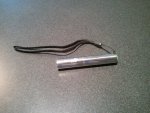 2011-05-14 09.06.45.jpg98 KB · Views: 1,067
2011-05-14 09.06.45.jpg98 KB · Views: 1,067 -
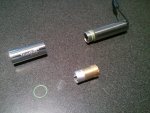 2011-05-14 09.08.40.jpg99.9 KB · Views: 960
2011-05-14 09.08.40.jpg99.9 KB · Views: 960 -
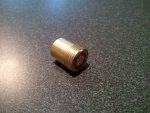 2011-05-14 09.09.24.jpg95.1 KB · Views: 944
2011-05-14 09.09.24.jpg95.1 KB · Views: 944 -
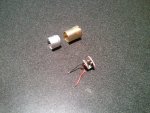 2011-05-14 09.17.34.jpg101.6 KB · Views: 1,187
2011-05-14 09.17.34.jpg101.6 KB · Views: 1,187 -
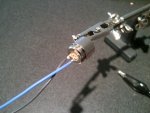 2011-05-14 09.45.13.jpg95.4 KB · Views: 1,012
2011-05-14 09.45.13.jpg95.4 KB · Views: 1,012 -
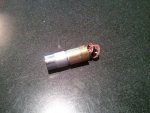 2011-05-14 10.18.26.jpg100.5 KB · Views: 954
2011-05-14 10.18.26.jpg100.5 KB · Views: 954 -
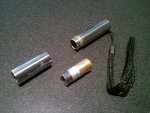 2011-05-14 10.28.16.jpg100.2 KB · Views: 1,008
2011-05-14 10.28.16.jpg100.2 KB · Views: 1,008 -
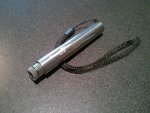 2011-05-14 10.34.21.jpg98 KB · Views: 1,245
2011-05-14 10.34.21.jpg98 KB · Views: 1,245
Last edited:





